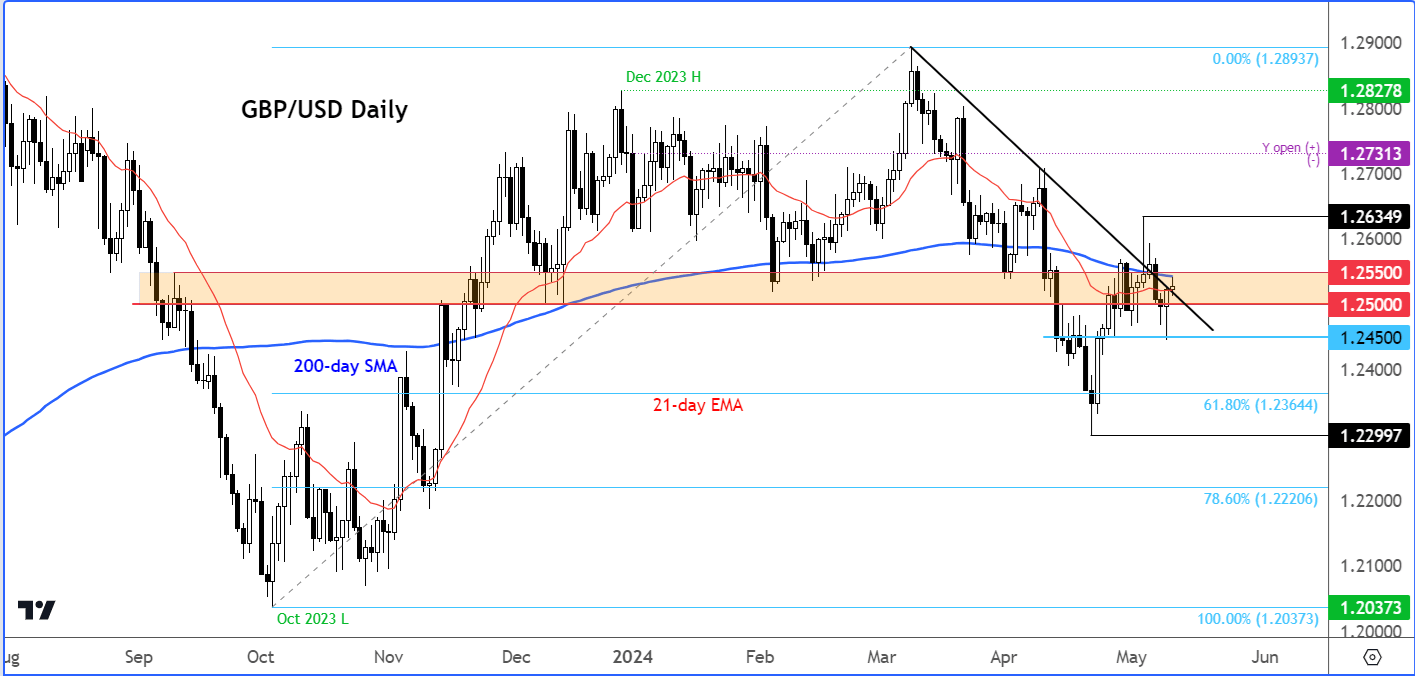
- GBP/USD outlook supported by 0.6% rise in UK’s economy in Q1
- Will BoE cut rates in June or August, is the key question
- US dollar hit by signs of cooling labour markets ahead of UoM data today and CPI next week
It has been a busy week for the GBP/USD, with traders having to deal with a slightly more dovish Bank of England and surprisingly strong data in the last two days. Meanwhile, the US dollar has weakened thanks to signs of weakening labour market there. More volatility is expected ahead for the cable. First up, we have the UoM consumer sentiment and inflation expectations data later on. UK wages and more importantly US CPI inflation data are on tap in the week ahead. The GBP/USD outlook could look a lot more bullish by next week, should US inflation data surprise to the downside. For now, the cable was still below the 200-day average, albeit it was showing constructive price action to suggest a bullish breakout may be on the cards.
GBP/USD outlook: UK’s economy rebounds strongly
The big news this morning was that the UK economy grew at an above-forecast 0.6% in the first quarter. This was largely thanks to a stronger performance in March when output rose by 0.4% m/m, although February GDP was also revised higher to 0.2%. GDP’s expansion was broad-based, but with significant contribution coming from the consumer-facing services (0.7% 3m/3m vs. 0.4% expected). The surprisingly sharp growth in Q1 suggests the economy is on the road to recovery after what has been an abysmal last couple of years with low output and high inflation keeping the economy in stagnation. The good news is that we have seen some positive momentum from business survey data in the early parts of Q2, suggesting there is some bullish momentum in the current quarter.
Will BoE cut rates in June or August?
With inflation now closer to the BoE’s target, a rate cut is still likely to come in the summer. Today’s stronger growth figures will not put off the MPC doves much. Will it be June or August, is what I am not too sure about, but the timing of it will definitely depend on incoming CPI and wages data from here on. After all, the BoE has just yesterday provided us with the strongest hint yet of a summer cut. The BoE Governor Bailey has that he’s optimistic that things are moving in the right direction for policy loosening. This is reflected in the BOE lowering its inflation forecasts to 2.6% in one year's time (previously 2.8%) and to 1.9% in two years' time (previously 2.3%). In fact, with 2 MPC members voting for a cut yesterday (Ramsden and Dhingra), which was one more than expected, a rate cut in as early as June wouldn’t be too surprising should we see a couple of below-forecast inflation and wages print. But given how the Fed has pushed back against early rate cuts, the BoE will not want to move too soon. So, Augusts seems more probably, data permitting. Speaking of....
GBP/USD outlook: UK wages data due on Tuesday
The GBP/USD outlook will be affected again come Tuesday. Hotter-than-expected wages data has kept the Bank of England refraining from committing to a rate cut in June, even if it has provided the strongest hint yet of a cut come the summer. The latest wages data has the potential to sharply impact UK interest rates pricing, which in turn could move the pound and the FTSE noticeably. The latter has hit 7 record highs in as many days. The Average Earnings Index unexpectedly remained at +5.6% in the three months to February compared to a year ago. With CPI cooling to 3.2% y/y in March, the BoE will need to see a corresponding drop in wages growth before it can be more confident that inflation is heading to its 2% goal in the medium term.
US dollar hit by signs of cooling labour markets ahead of CPI
The US dollar sold off on Thursday following the disappointing jobless claims data, which rose to 231K vs. 212K expected, up sharply from 209K the week before. The data provided fresh evidence of a cooling US labour market, following the publication of a weaker non-farm jobs report we saw the week before. The weakening labour market data has helped to support the view that the Federal Reserve is going to cut rates by around September.
The focus is starting to turn to inflation data in the week ahead. Ahead of it, we have the UoM’s consumer sentiment and inflation expectations data later today.
Inflation Expectations has climbed steadily from 2.9% in January to 3.2% in April. With recent economic data weakening, will inflation expectations also ease? Meanwhile, the UoM’s consumer sentiment survey could potentially overshadow the inflation expectations survey in the event of a big surprise. This gauge has disappointed expectations recently and is expected to print 76.3 compared to 77.2 previously.
Until inflation data is released next week to help gauge when there might be a shift towards lower interest rates, any further dollar selling we may see today or in early parts of next week could be limited. We have heard from a few Federal Reserve officials this week, all suggesting that interest rates may need to remain at these high levels for a longer period than previously anticipated in order to moderate demand and alleviate inflationary pressures.
Despite the recent weakness in several survey-based US data, ongoing concerns about persistent inflationary pressures remain. Ahead of CPI on Wednesday, we will have seen the latest PPI figures the day before. Together, the PPI and CPI data for April have the potential to intensify or reduce inflation concerns significantly depending on the direction of the surprise. CPI has consistently beaten expectations since the turn of the year. The Fed and dollar bears will be hoping to see a softer print for a change, else rate cut expectations could be pushed out further.
GBP/USD technical analysis

Source: TradingView.com
Following this week's macro events, the GBP/USD has broken its short term bearish trendline, after finding good support at 1.2450. At the time of writing, rates were inside a key resistance zone around 1.2500 to 1.2550 area. This is where we have 200 day moving average and prior support are converging. A potential break above this area would be a bullish outcome, which could pave the way for a run towards 1.2700 and possibly higher in the days and weeks ahead, data permitting. However, if support at 1.2450 gives way first, then that would be bearish, which potentially may pave the way for a drop to a new yearly low beneath 1.2300. This however is not my base case scenario as I am bearish on the US dollar.
-- Written by Fawad Razaqzada, Market Analyst
Follow Fawad on Twitter @Trader_F_R
How to trade with City Index
You can trade with City Index by following these four easy steps:
-
Open an account, or log in if you’re already a customer
• Open an account in the UK
• Open an account in Australia
• Open an account in Singapore
- Search for the company you want to trade in our award-winning platform
- Choose your position and size, and your stop and limit levels
- Place the trade










